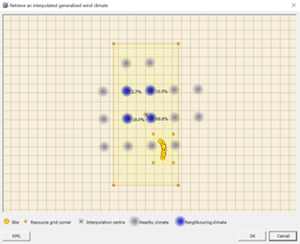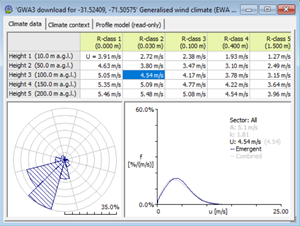WAsP 12.6
In WAsP 12.6 we introduce automatic import of Generalised Wind Climate (GWC) files from the Global Wind Atlas. When inserting a GWC from the Global Wind Atlas, WAsP uses the coordinates of met stations, turbine sites, reference sites and resource grids to calculate the position of the interpolation centre. Subsequently, WAsP uses the interpolation centre and the nearest neighbour algorithm to assign weights to GWC files from the Global Wind Atlas and calculate an interpolated GWC.


We have decided to add this new feature to provide easy and correct access for WAsP users to wind climate data from the Global Wind Atlas. Please note that wind climate data from the Global Wind Atlas are associated with varying accuracy and uncertainty, ref. Global Wind Atlas. Therefore, wind climate data from the Global Wind Atlas should be used to perform preliminary calculations only – especially in areas with complex terrain.
WAsP 12.6 also includes a new site similarity report (script), which calculates dissimilarities between the met. station and the turbine/reference sites, including speed-up dissimilarities according to a new method developed by DTU[1].
Furthermore, WAsP 12.6 uses updated barometric reference data from the ERA5 reanalysis, and a variable temperature lapse rate is included in air density calculations. This gives an improved estimation of air density as described here: https://www.mdpi.com/1996-1073/12/11/2038
Finally, WAsP 12.6 includes a significantly updated help file.
WAsP CFD result viewer 1.3
This release includes “WAsP CFD result viewer” version 1.3, displaying WAsP CFD results. The new features are:
- Flow correction from one position to another
- Map-based site assessment
Map-based site assessment uses a combination of WAsP CFD results, wind climate data calculated with other WAsP Suite software, turbine data and the IEC wind turbine class. This enables mapping of mean wind speed, mean wind probability, extreme wind speed, effective turbulence intensity, wind shear, flow inclination angle, power density and gross annual energy production within the WAsP CFD result domain. It is also possible to mask areas, which according to the IEC standard have non-compliant wind conditions, and display site assessment details for a selected site.
Windfarm Assessment Tool 4.6
WAT 4.6 includes a few new features, including export of observed turbulence statistics for import to the WAsP CFD result viewer.
You can download the WAsP suite installer and get the release notes here: https://www.wasp.dk/Download/WAsP12-Suite-Installer
[1] Bechmann, A., Leon, J. P. M., Olsen, B. T., and Hristov, Y. V.: The most similar predictor - on selecting measurement locations for wind resource assessment, Wind Energ. Sci., 5, 1679-1688, https://doi.org/10.5194/wes-5-1679-2020, 2020.